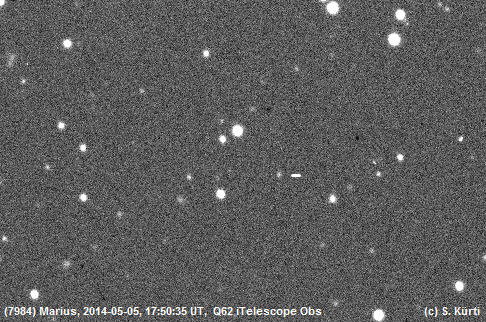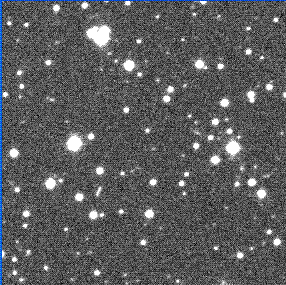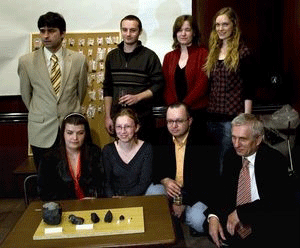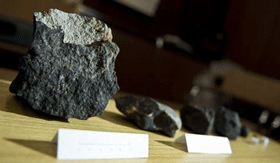
2014 June 14
Near Earth Asteroid 2012 LG11 discovered
in pro/am and international cooperation
Hungarian astronomer Krisztián Sárneczky, regularly hunts for asteroids and comets
by 60 cm Schmidt telescope of Konkoly Observatory, Piszkéstető, Hungary. Since
the autumn of 2010 I cooperate with him and help with the astrometry of acquired
images, usually remotely from my home in Nove Zamky, Slovakia, 180 km far from the observatory.
The telescope setup with attached CCD camera produces, depending on season, 20-50 triplets
per night with FOV=70´x 70´, which is impossible to check visually.
To check one triplet of images requires approx 30-45 minutes. In order to
process all images Krisztián uses program Astrometrica, which has also function
for moving objects detection. So instead of half an hour or so, it is checked
during several minutes.
However we found out that the program, no matter how sophisticated it is, has its
limits and does not catch all the moving bodies. The human eye detects about 1
magnitude fainter than Astrometrica and another disadvantage of it is that if
there is a star occulted by a moving asteroid, the program would not identify it
as a moving object. Usually I am able find from 5 to 10 new asteroids in areas
close to the ecliptic, which the identification software missed. As we observe
further from the ecliptic plane, there are less moving objects, so the checking
work becomes less fun and often I do not find even a single object on such images.
On Friday June 15th Krisztián let me know that new CCD images are to be viewed,
but warned me that as he observed far from the ecliptic, certainly there should
be just a few asteroids, maybe none ... As it turned out, he was not quite right!
In the evening I downloaded new images, but finally I did not managed to check
them. Only after usual family shopping on Saturdays I sat down to my computer
and uploaded the first CCD triplet. In the one third of the image I noticed a
short dash between the stars, so I stopped the automatic blinking and get through
all three pictures manually. Unfortunately it was just an optical flaw as in the
other two shots was nothing. I slowly moved on and another trail appeared there
again, this time longer one, stronger, and on all three images with a clear shift.
It was clear to me what I see at once - a fast moving object, possibly near earth
asteroid! Geostationary satellites leave longer trail and are further away from
each other.
At that moment I recalled my excitement from late summer of 2005 when I discovered
my first NEA 2005 QP87 in the FMO Spacewatch Project. This time, no panic and
chaos - I proceeded the things with ease - I did the astrometry and went to the
web portal of Minor Planet Center, where in the section NEO Rating you can check
whether the observed body could be a NEO. After entering my positions in the empty
box, on monitor of the computer promptly jumped the answer - inspected body was
with 99% NEO!

There was no need for hesitating anymore, I typed the SMS to Krisztian about the
suspected object. Then I sent an e-mail message with attached data, and thirdly,
I left a message for him through the skype. Two hours passed and nothing happened.
At last my computer announced the answer. Krisztián was absolutely thrilled and
then it passed to me too. He immediately forwarded the data to the MPC. In less
than an hour it was already published on the NEOCP list , i.e. on list with objects
that urgently need further observation. The weather was helpful with totally clear
sky, so the Schmidt telescope were directed at the location on the sky were the new
cosmic wanderer supposed to be. Over the next 60 minutes Krisztián detected and
confirmed our discovery.
Asteroid was quite close to the predicted location. Fortunately with the 18
magnitude bright object 30 seconds exposure was enough to capture it.
The discovery was quickly confirmed by other observers as well - by four
observatories. And on Sunday evening, an official report on MPE Circular was
published about NEO asteroid 2012 LG11.
Only then I realized what happened - I felt the satisfaction that many hours I
spent in front of my PC monitor were useful. Although the asteroid escaped from
detection software, it was caught by me. I added 4th Near Earth Asteroid to my
"collection" which I started seven years ago. This time, an estimated 600-800
meters sized rock, which would obviously cause problems if it directed into our
atmosphere.
Although the sky is routinely and daily monitored by large automatic
surveys, discoveries are not restricted only to the big players. Even an amateur
in collaboration with professionals can contribute. And the next discovery may
happen anytime.
2012 June 20
Asteroid (4178) named in honour of Alexander Mimeev
Russian amateur astronomer Alexander Mimeev is a keen NEAT images reviewer. He is
searching for precovery observations of newly discovered asteroids. He contibuted
positions for hundreds of new minor planets, which were numbered shorly after their discovery.
So the artificial group of Main Belt asteroids - named after NEAT images reviewers has
another member - (4178) Mimeev. To the group belongs those asteroids:
(9706) Bouma, (73491) Robmatson, (51983) Hönig, (183294) Langbroek, (52005) Maik,
(132798) Kürti, (4858) Vorobjov, (4091) Lowe, (196035) Haraldbill and (234761)
Rainerkracht.
2012 May 24
New minor planet 2006 TR130 from Sloan Digital Supernova Survey images
Recently I added to my observatories
"collection" from I have discovered new asteroids another one - Apache Point (705)
from New Mexico, USA. Sloan Digital Supernova Survey, as it implies from its name,
searched for new supernovaes. You can find a lot of asteroid positions there, as astronomers did not measured images
for this reason. I search archival images for precovery positions of NEO
and MBA and found my first MB asteroid from SDSS: 2006 TR130.
2011 Dec 10
My first remotely discovered asteroid has been numbered: (275264)
I found my find first asteroid from night
remotely via RAS observatory in New Mexico, USA. Subsequently it was linked
observations from other 4 oppositions so minor planet previously known as a 2010 AB4
got number (275264).
2011 Sep 15
My first discovery from Southern Hemisphere: 2010 JS152
RAS observatory network enables
remotely observation not only from Northern Hemisphere but also from "Down Under".
I started my observation from Moorook, Australia at the beginning of May.
During my follow up observation of minor planet 2007 YA4 I catched up also 1 unknown object.
Although following 8 days I could not observe it for second night due the bad weather,
I found it on 9.th day and it received provisional designation 2010 JS152.
2010 May 30
Meteorite Kosice
Very bright bolide exploded over Central Europe on 28. feb. 2010. Despite of bad
wheather two industrial cameras from Hungary catched it so astronomers from Hungary,
Slovakia and Czech republic were able to compute its probably place of fall.
As today announced astronomers from Astronomical Institute of Slovak Academy of
Science in Stara Lesna(near Skalnate Pleso) international group of astronomers
searched for meteorite in predicted area of about 20 km2 last week.
They were succesful and found 64 pieces of it. Biggesst piece has 12 cm and weight
2,19 kg, the smallest is 0,8 cm and only 0,57 g. Astronomers named it after nearby
town of Kosice. It is chondrite H5. They estimated it as 1,5 meter small object
which exploded 35 km above the ground.
It is 6th meteorite found in Slovakia.

Foto: TASR/Luká Furcoň

Foto: TASR/Luká Furcoň
Read more about it:
Meterorite Koice
2010 Mar 31
New comet discovery from NEAT images P/2001 Q11 (NEAT)
The comet hunter Maik Meyer from Germany catched
an unknown comet from SkyMorph archive. During searching for precovery positions
of recent comet he found a new periodic comet P/2001 Q11. There are still many
new objects waiting for discovery in NEAT images!
Read more about it by his own words:
P/2001 Q11 (NEAT)
2010 Mar 20
My new discoveries from night sky: 2010 EM12 a 2010 EZ21
I would like to follow up some of my discoveries, but with
RAS Observatory I cannot reach them. I found out that telescopes of Sierra Stars
and Rodeo observatories allow this. So I tried those telescopes and found 2 new asteroids
- 2010 EM12 at Sierra Stars (G68) and 2010 EZ21 at Rodeo (H11).
2010 Mar 15




